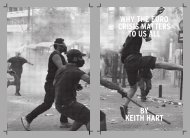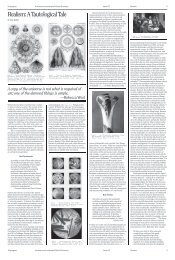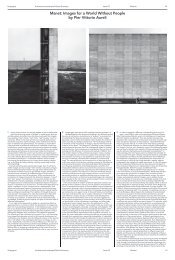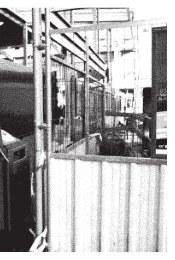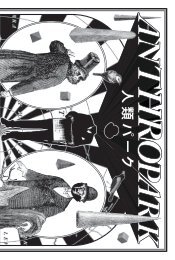Full Issue - Scapegoat
Full Issue - Scapegoat
Full Issue - Scapegoat
You also want an ePaper? Increase the reach of your titles
YUMPU automatically turns print PDFs into web optimized ePapers that Google loves.
<strong>Scapegoat</strong> Architecture/Landscape/Political Economy<br />
<strong>Issue</strong> 01 Service<br />
21<br />
itself in revolutionary politics and practice.<br />
The result is both more abstract and more<br />
precise, retroactively casting a certain<br />
light on the earlier importance of ephemerality<br />
in architecture.<br />
Particularly striking is the anonymously<br />
written (though it was later attributed to<br />
Baudrillard) polemical text, “The Environmental<br />
Witch Hunt.” Baudrillard and Jean<br />
Aspin brought this as their contribution to<br />
the 1970 International Design Conference<br />
in Aspen, where they appeared as part of<br />
the “French Delegation.” 4 In the current<br />
context of global warming and greenwashing,<br />
where virtually all design funding<br />
goes to “developments in sustainability,”<br />
this piece has only become more<br />
meaningful. It is worth quoting here:<br />
The therapeutic mythology which tries<br />
to convince us that, if things are going<br />
wrong, it is due to microbes, to virus,<br />
or to some biological dysfunction, this<br />
therapeutic mythology hides the political<br />
fact, the historical fact that it is a<br />
question of social structures and social<br />
contradictions, not a question of illness<br />
or deficient metabolism, which could<br />
easily be cured. All the designers, the<br />
architects, the sociologists who are<br />
acting like medicine men toward this<br />
ill society are accomplices in this interpretation<br />
of the question in terms of<br />
illness, which is another form of hoax. 5<br />
This critique of environmentalism,<br />
which we can now extend to sustainability,<br />
biopolitics and biomorality, is<br />
precise. Such a clear denunciation of the<br />
post-critical hoax leaps from these pages<br />
like a lightning-bolt from a turbulent sky.<br />
Notwithstanding the aforementioned<br />
treatment of urbanism by various contributors<br />
in the earlier issues, it is primarily<br />
the texts by Baudrillard that provide the<br />
explosive force in Utopie.<br />
There are a number of other important<br />
themes from the issues of Utopie covered<br />
in this compilation. Two articles dedicated<br />
to “technics,” one of which was<br />
also written by Baudrillard, develop an<br />
interesting critique of technology on the<br />
grounds that it participates just like other<br />
“cultural” forms in the structuring of the<br />
class system. As well, a number of articles<br />
dedicated to the question of death mark<br />
the end of the volume.<br />
In a design world saturated by images<br />
of current and past projects (particularly<br />
en vogue are the radical, utopian<br />
projects of the ’60s and ’70s) and utterly<br />
confounded by post-critical and pseudotechnical<br />
discourses such as sustainability,<br />
intelligent systems, and emergent forms,<br />
moments of critical lucidity such as these<br />
are most valuable. The helpful introduction<br />
and afterword allow the volume to<br />
be read with an eye toward their original<br />
context. However, it is equally viable and<br />
perhaps more exciting to read these texts<br />
against contemporary problems in design<br />
and design theory, problems which<br />
largely had their roots in the time of this<br />
journal’s publication. Utopia was not written<br />
in the future tense!<br />
Will Hutchins Orr is a graduate student<br />
at the Faculty of Architecture, Landscape,<br />
and Design of the University<br />
of Toronto. His current thesis work<br />
involves the difficult relationship<br />
between architecture and the city. Drawing<br />
on the history of city-states, his<br />
project centres on the radical potential<br />
of territoriality to combat “urbanism”<br />
in the contemporary city.<br />
Notes<br />
1. Craig Buckley and Jean-Louis Violeau,<br />
eds., Jean-Marie Clarke, trans. Utopie:<br />
Texts and Projects, 1967-1978 (Los Angeles:<br />
Semiotext(e), 2011), 131.<br />
2. Ibid., 91.<br />
3. See Manfredo Tafuri, “The Ashes<br />
of Jefferson” in The Sphere and the<br />
Labyrinth (Cambridge Mass.: MIT Press,<br />
1987), 291-303<br />
4. Buckley and Violeau, Utopie, 17.<br />
5. Ibid., 243.<br />
Ethics for Architects: 50 dilemmas of<br />
Professional Practice<br />
Thomas Fisher, Princeton Architectural<br />
Press, 2010, 144 pp.<br />
The Ethical Slut: A Guide to Infinite<br />
Sexual Possibilities<br />
Dossie Easton and Catherine A. Liszt,<br />
Greenery Press, 1997, 280 pp.<br />
Reviewed by Christie Pearson<br />
Thomas Fisher is Dean of the College of<br />
Design at the University of Minnesota. His<br />
book, Ethics for Architects, irritated me, and<br />
I felt the need to have a companion work<br />
as a foil to help me understand why. The<br />
Ethical Slut by Dossie Easton and Catherine<br />
A. Liszt jumped off the shelf. The following<br />
passages suggest a certain affinity between<br />
the two texts:<br />
“To my father, who first sparked my interest<br />
in ethics, and my mother, who showed me<br />
how to live a good life.”<br />
—Fisher, Ethics for Architects, dedication.<br />
“So focus on abundance, and create your<br />
environmental ecology rich in the good<br />
things of life—warmth and love and sex.”<br />
—Easton and Liszt, The Ethical Slut, 183.<br />
These two quotes both take goodness<br />
to be worthwhile, something we should<br />
think about. It is suggested that the reader<br />
might share the authors’ definitions of the<br />
good, though perhaps they suggest two<br />
common but different goods. Fisher may<br />
mean his mother taught him to be good<br />
as opposed to bad. Or, perhaps he means<br />
that his father taught him to be good while<br />
his mother taught him to live well. Easton<br />
and Liszt make it clear what good means for<br />
them—the enjoyable, delightful, and pleasurable,<br />
which type of good is often placed<br />
in opposition to that which is ethically good.<br />
I am interested in this division, and I think it<br />
points to some exiled aspects of the good<br />
that common wisdom neglects.<br />
Fisher is interested in professional ethics<br />
and the public responsibility that extends<br />
beyond the personal in the activities of the<br />
architect. Ethics for Architects is structured<br />
into chapters following the six canons of<br />
the American Institute of Architects’ Code<br />
of Ethics and Professional Conduct (AIA<br />
2008): 1<br />
1. General Obligations<br />
2. Obligations to the Public<br />
3. Obligations to the Client<br />
4. Obligations to the Profession<br />
5. Obligations to Colleagues<br />
6. Obligations to the Environment<br />
This list seems self-evident, being nearly<br />
a definition of what makes any profession<br />
a profession. As it is entwined with law, the<br />
profession reproduces forms which society<br />
has come to agree, voluntarily or otherwise,<br />
are beneficial to all. The engineered, 42-<br />
inch guardrail, for example, might not be in<br />
every client’s interest, or even desirable, but<br />
a future inhabitant will have the confidence<br />
that it’s regulated by safety standards. Each<br />
chapter analyzes a series of situations<br />
where an architect may encounter conflict.<br />
Approaches to an individual’s ethics include<br />
virtue in character and duty in action, while<br />
for a group, contractual and utilitarian in action.<br />
One of the book’s goals is to remind us<br />
that all of these dimensions are important in<br />
an architect’s practice.<br />
Professions expressly claim to be<br />
servants of the public. Professional organizations<br />
of architects operate as both<br />
advocates of the profession within society<br />
and police who monitor and regulate the<br />
profession from within. We like to believe<br />
that professions have been created to serve<br />
and protect us. We are outraged when<br />
a doctor or professor is influenced by a<br />
private enterprise, as it threatens to compromise<br />
the safety that we gain from society<br />
in exchange for going along with its regulations.<br />
In the West, we are experiencing an<br />
onslaught of private influence on the public<br />
realm. Privatization, loss of jobs in the civil<br />
service, and de-regulation are dismantling<br />
the institutions and workforces that were<br />
created to serve the public. It is unlikely that<br />
professions as they exist today will be able<br />
to withstand this movement, and in some<br />
sense Ethics for Architects is a plea for their<br />
relevance and future.<br />
I am both a professional architect and a<br />
socialist in the way I favour well-structured<br />
safeguards for the public realm. I actually<br />
want them to increase, not decrease. Yet<br />
even as Ethics for Architects appeals to my<br />
pride and professionally endorsed claim to<br />
moral superiority, I lose my enthusiasm. The<br />
actions of architects everywhere belie this<br />
law-enforced submission and arrogance:<br />
we are surrounded by buildings which are<br />
neither virtuous nor delightful. Anarchism<br />
seems preferable, and The Ethical Slut<br />
feels like a. For example, Easton and Liszt<br />
say they are in favour of “agreements”<br />
over “rules.” But what are the differences<br />
among laws, rules, and agreements? Laws<br />
are created by society and are enforced by<br />
the state through the police and judiciary<br />
system; they are involuntary unless you<br />
step out of society itself. Laws apply to the<br />
largest group, a whole nation, for example.<br />
Rules, so elegantly praised by Huizinga in<br />
Homo Ludens, are created by the collective<br />
folk game-makers and enforced by participants<br />
themselves; they are voluntarily submitted<br />
to within a specific temporal-spatial<br />
frame. 2 Rules only apply to those people<br />
who want to play. Finally, agreements are<br />
created as needed by individuals or groups,<br />
their particulars worked out through backand-forth<br />
negotiations to be amenable to<br />
all. They may be long- or short-lived; they<br />
may be for just two people.<br />
Submission is a common ingredient of<br />
laws, rules, and agreements, but the spirit<br />
of that submission can vary. We can also<br />
establish rules and agreements just for<br />
ourselves. We can voluntarily take on externally<br />
created laws and imagine, project, or<br />
internalize a figure who will enforce these<br />
laws. Agreements, rules, and laws become<br />
more complicated as one moves into<br />
psychology, and free choice can become a<br />
relatively useless concept. Easton and Liszt<br />
posit their version of a delightful world and<br />
a good life as run on agreements, free will,<br />
and adventure, with all of these ingredients<br />
being necessary in establishing an ethics.<br />
Arguably, the question of responsibility in<br />
action and word are just as important in<br />
Review<br />
Ethics for Architects, The Ethical Slut<br />
<strong>Scapegoat</strong> Says: You have City staff serving tea<br />
in here. How did you convince the staff that<br />
their job description was going to change?<br />
JM: Rink guards, they were all guys. So we started<br />
by saying we need girls as well as guys. So<br />
Tino, the supervisor, said OK. They hired two<br />
female university students. It was really hard for<br />
them, people gave them a tough time. In 1997<br />
it was very rare to have women working in the<br />
rinks because it was perceived as tough, with an<br />
edgy vibe. Then the families came.<br />
1999: Ten thousand skaters use the rink.<br />
JM: Every year users doubled. We didn’t anticipate<br />
the success of the skate rental. Tino heard<br />
you could get equipment from the NHL Players’<br />
Association, like complete hockey outfits. We<br />
got 50 sets and kept the sticks, gloves, helmets,<br />
and skates. We realized that what was keeping a<br />
lot of people from skating was skates, especially<br />
new immigrants. Then we got even more donations,<br />
over 100 pairs.<br />
2000: Founding of the Centre for Local Research<br />
into Public Space (CELOS), a research<br />
organization connected to Dufferin Grove. 2<br />
CELOS, whose acronym is inspired by Ivan<br />
Illich’s CIDOC (Centro Intercultural de Documentación),<br />
is a non-profit corporation focusing<br />
on urban public spaces, commons and<br />
parks. Their mandate is to research the use<br />
and administration of public spaces, as well as<br />
experiment with new ways of using and disseminating<br />
information about them.<br />
SS: Are there other places or people who have<br />
inspired you?<br />
JM: Yes. One is the Peckham Experiment, which<br />
went on between wars in working-class England.<br />
Private money built a community centre, and<br />
you could join for very little money. They had<br />
a farm, the building was made out of glass so<br />
you could see everyone. It was drop-in and you<br />
could do as you wanted. Another inspiration is<br />
the Children’s Storefront in Toronto. Started in<br />
1976 on Bathurst Street, it is just an old store you<br />
could drop in five days a week. My kids semigrew<br />
up there. No classes, no circle time, just<br />
caregivers and children, and you could read or<br />
meet other parents. It’s all about friendship. The<br />
key elements here are drop-in, no classes, and<br />
fostering friendship in community. Riva Novick<br />
started it—respecting parents as full, underslept<br />
adults. Not like the community centres where<br />
you felt like you were in kindergarten, there was<br />
interesting political conversation. Kind of like<br />
the playground: the kids are busy, you find interesting<br />
people. No infantalization!<br />
2002: Weekly Farmer’s Market begins.<br />
2003: Weekly Friday Night Suppers begin.<br />
2004: City inspectors try to shut down community<br />
use of the rink house’s zamboni room.<br />
JM: The building acts as a staging area for the<br />
rest of the park activities. The kitchen funds the<br />
playground café. Just before Christmas some<br />
health and safety inspectors said ‘Hey, you can’t<br />
have a kitchen where the zamboni is, take it out!’<br />
They told us lots of made-up rules. It got in the<br />
papers. In the garage we had puppets hanging<br />
from the rafters—they made them go. They<br />
said a space with a zamboni can’t have anything<br />
else in it, but there is in fact no such recognition.<br />
People started talking about what a multipurpose<br />
room should be. Why should it be used<br />
just three months of the year? You have to just<br />
keep saying ‘This doesn’t make sense!’ Eventually<br />
though, they will cave in if you are determined<br />
enough—but they’ll never say, ‘You were right in<br />
the first place.’<br />
It’s interesting how a building so unimaginative<br />
can be so flexible, because it’s long and not<br />
already set up. And for such a tiny amount of<br />
money! I love cheap buildings, cheap parks. People<br />
think that’s a bad word: it means you want<br />
things to fall down! This is also connected to the<br />
feminine, though. Women know what to do: use<br />
what’s in the pantry already.<br />
2005: Breastfeeding becomes a public controversy<br />
when a community member breastfeeding<br />
in the living room-like rink house gets into<br />
an argument with Mason, who is pro-public<br />
breastfeeding, but objected to the specific<br />
context. Media coverage highlights the nuances<br />
and complexities of behaviour in public<br />
places.<br />
2010: Scandal: a well-loved park supervisor is<br />
transferred to another district and local residents<br />
suspect the City of trying to undermine<br />
the creative collaboration.<br />
SS: These last two events bring us to the present<br />
state of Toronto, a shifting territory marked by<br />
right-wing privatizers at City Hall and the continuing<br />
decline of funding for city parks, public<br />
housing, and a host of other amenities taken<br />
for granted before the 1998 amalgamation. The<br />
newly formed Park People group has grown out<br />
of Dave Harvey’s 2010 Metcalf Foundation report<br />
on the state of Toronto Parks. 3 The report<br />
offers Dufferin Grove as a model of what our<br />
parks could be if we transformed our passive relation<br />
to the city into an active one. However, the<br />
report also makes examples of American parks<br />
operated or funded by individual and corporate<br />
funds. At a Park People summit, Tupper Thomas,<br />
the public administrator of Prospect Park in<br />
Brooklyn, proudly described the rejuvenation of<br />
the park by volunteers, noting at the same time<br />
that the number of park employees has declined<br />
dramatically over the past few decades. Only<br />
one Toronto counselor present at the meeting<br />
stood up to contest the under-funding of the<br />
Parks, Forestry and Recreation Division. It is clear<br />
that the City of Toronto feels it is unable to dedicate<br />
the tax dollars and collective energy that<br />
would be required to transform its own parks.<br />
In this context, the most entitled citizens of<br />
our cities will get what they want in their neighbourhoods,<br />
but there are many parks in the<br />
city that may never find a group of volunteers<br />
to make them safer, more beautiful, dynamic or<br />
useful. British Prime Minister David Cameron has<br />
called on ‘volunteerism’ to relieve government<br />
from its role as protector of the public realm.<br />
Around the world there is a strong tension today<br />
in terms of what we want our governments to<br />
be: paternal disciplinarians, invisible entities allowing<br />
self-regulating individuals and groups to<br />
actualize as they wish, or collective voices serving<br />
all citizens equally. We are called upon to<br />
make our next move!<br />
Notes<br />
1. Friends of Dufferin Grove Park website,<br />
www . dufferinpark.ca/home/wiki/wiki.php<br />
2. Center for Local Research into Public Space<br />
website, www.celos.ca/wiki/wiki.php<br />
3. Park People website: www.parkpeople.ca; see<br />
also Fertile Ground for New Thinking:<br />
www.8-80cities.org/Articles/Fertile_Ground_for_<br />
New_Thinking%20-%20Toronto%20Parks.pdf<br />
Project<br />
Friends of Appropriation<br />
21



